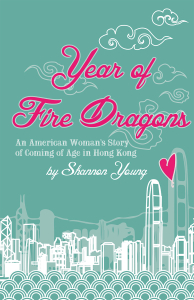Shannon Young’s Year of Fire Dragons begins and ends with a dragon dance celebrating the Mid-Autumn Festival. What transpires in between is a delightful account of one year in a young American woman’s life in one of the most exciting and unique cities in the world. Like a museum tapestry that fascinates with the events it records as much as its intricate craftsmanship, Young’s book is as engaging a memoir as it is a treat in rhetoric and imagery in the descriptions of the picturesque, multi-faceted arena of Hong Kong’s modern life. The love story that is the core of the novel forms the connecting threads that hold this unique tapestry together and make it whole.
What motivates Young to leave her family home in Arizona is Ben, her own Mr. Darcy as she calls him. But unlike Mr. Darcy, he is Eurasian, with a British father and a Chinese mother, and he is outgoing and “open-faced” as she describes him at their first meeting at a fencing club in London during her college semester abroad. She soon falls head over heels for him before the semester is out and she has to return to college in New York. Upon graduation, she secures a job as a teacher of English in an elementary school in Hong Kong, and heads out there to be with Ben, only to say goodbye to him a month after her arrival, as his work takes him to London again. Rather than following him to London, she determinedly stays in Hong Kong, alone, initially quite friendless, submitting herself to constant culture shock but ready to make the most of her experience in Hong Kong while waiting for Ben to return. So begins a long-distance relationship, with physical rendezvous in London and Hong Kong months apart. Cyberspace is their regular meeting place.
And what of the physical rendezvous? Anyone looking for a sensually provocative read would be disappointed; but that is not what the author intends the book to be. Instead, what readers get is a story that touches many aspects of Young’s first year in Hong Kong, most of which time Ben is in London. Young does refer to Ben as her lover, but that is as far as the reader gets out of her. What makes the novel genuinely engaging is the story of a young American woman’s year-long rite of passage from the security of a happy home and somewhat sheltered environment in Arizona, via her first step out of that comfort zone to Colgate University, New York, and ending in a totally strange city thousands of miles away, where she is thrust into all-out culture shock, and in the process grows into a confident, independent, self-sufficient young woman.
Whether locals or strangers to Hong Kong, readers are treated to a refreshing perspective on this city once named the Pearl of the Orient, an old endearing reference in its British colonial days. Young’s depictions of food come alive in print, whether ready for the table or pre-cooked. Her first experience with the delectable xiaolongbao (steamed soup-filled dumplings) ends in a scalded tongue. On one of her first strolls through a market district, she lends wry humor to a grisly observation: “I once saw one quarter of some sort of ram or goat hanging in a shop. It had been sliced so its head, one horn, one hoof, one shoulder, and one leg were all still attached.” Such is Young’s intense power of observation.
Humour lends itself to Young’s memoir, subtle or otherwise, arising from cultural blunders, like the time when Young strips naked at the massage parlour — much to the dismay of the masseuse. When she tells Ben about it, he laughs: “The Chinese aren’t really comfortable with nudity.”
One of the funniest moments is when Young drinks water from the bowl for rinsing chopsticks the first time she joins other teachers at lunch in a restaurant. There is unintentional humour in casual conversation between Young and some of the Chinese teachers at her school.
“Hi Miss Lo. How’s it going?”
“I am going to the library.”
Cultural differences are distinct throughout the book, in table manners and cuisines, in methods and principles of teaching, in what is polite and what is not, what is politically correct and what is not — in short in all facets of Eastern and Western society. It isn’t easy for Young, raised and educated in America, to understand why, in Hong Kong schools, mistakes are not okay even if making them helps one to learn. The bitter taste of cultural differences is oftentimes abated with the salt of humour that comes with them. It is delightfully funny when Young remarks of an associate’s manner of talk, “I was used to Chinese yelling by now, and his Mandarin was not nearly as intimidating as the harsher tones of Cantonese.”
Young’s use of figurative language is overpowering. When color-coding Hong Kong with her friends while caught in the aftermath of the Rugby Sevens, she says of Hong Kong:
“It’s more of a red with hints of electric blue. I think of China as a red country, but Hong Kong is red in a rich, vibrant, energetic sort of way. China is a bit more austere. The electric blue is the city lights and the futuristic vibe of the city.” Such is Young’s fine mastery of descriptive language.
Year of Fire Dragons excels not only as an unique biographic guide to Hong Kong, but Young has cleverly inserted recent history of the 1950s and 1960s and descriptions of life in the then British colony into the workings of the book, with passages from her grandmother’s letters, offering a glimpse of a time gone by when her grandparents were living in Hong Kong. Young effects a fine juxtaposition of her sister Chelsea’s wedding in Arizona in 2011 and a Tanka wedding in Hong Kong in 1961. As well, Young uses her visit to the Hong Kong History Museum to inform readers on Hong Kong’s history from its earliest settlements.
In the midst of all her experiences in her first year in Hong Kong, Young never loses sight of the reason she is there. She keeps Ben alive in her daily thoughts and actions, reminding readers of him in faraway London. She makes it clear that hope and the expectation of ultimately spending her life with Ben are what make living alone in Hong Kong bearable for her — although as the year goes on, she no longer feels the same loneliness she had at the beginning, and she accepts, actually enjoys, her solitary but not lonely life in Hong Kong while waiting for her lover to return, sometimes not without doubt as to whether things will work out for them. Hong Kong has grown on her. Halfway into her memoir, Young writes, “I was definitely not a visitor anymore, a temporary drop in the vast sea of this city. Perhaps I was supposed to be here amidst the skyscrapers and the city lights and the flurry of languages from around the globe.” And later still, she writes, “Hong Kong had gotten into my soul and there was no turning back.” Bit by bit, Young has built a life for herself there. She has come of age in Hong Kong. And when Ben comes home to Hong Kong at the end of the year and of the book, she is there to receive him unequivocally, without reservation or doubt.
A very enjoyable read indeed.
Reviewed by Elsie Sze, author of Ghost Cave, Hui Gui and The Heart of the Buddha
Year of Fire Dragons is published by Blacksmith Books.

